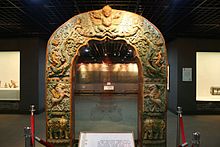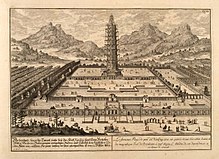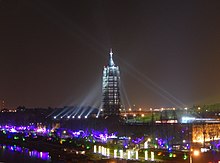Porcelain pagoda
The Porcelain Pagoda (also known as the Porcelain Tower) was a 79 meter high pagoda built in Nanjing in the early 15th century . The tower consisted of nine floors and was covered with porcelain plates. During the Revolution of Taiping 1852-1864 it was completely destroyed. A modern replica of the tower was opened in Nanjing at the end of 2015.
history

The porcelain pagoda is said to have been commissioned by the Ming Emperor Yongle in 1412 . It took 17 years to complete the tower, which was part of a temple surrounding it. The Chinese name of the temple was "Bao'en Si", which translated means "temple of great gratitude".
One of the first mentions of the porcelain tower in Europe took place between 1613 and 1635 by Father Samado. The Italian Jesuit Martino Martini , who traveled to China in 1643, was one of the first to describe the pagoda in a book. Johan Nieuhof , a Dutchman who worked for the East India Company , described the pagoda a little later in his China report from 1665, which also contains copper engravings of the pagoda. Nieuhof's reports and representations became particularly popular and were translated into different languages, which is why they shaped the image of Europeans on China and the porcelain tower in a special way and were an inspiration for architects, writers and artists in Europe.
In 1853, Nanjing was captured by the Taiping Rebels , Chinese Christians who rebelled against the Qing Dynasty . It is said that the tower was still standing the following year, but was completely destroyed by the rebels in 1856.
description

The pagoda had an octagonal base with a diameter of about 30 meters and was about 79 meters high with its 9 floors. There were originally plans to add 4 floors to the tower and thus to reach a height of 101 meters, which was never implemented. At night the pagoda was illuminated by around 140 lanterns. The pagoda was clad in white porcelain stone and inside a spiral staircase with 190 steps led upwards. The panel, in which Buddhist depictions of animals, plants and landscapes were incorporated, is said to have shone in the sunlight.
Meaning and reception
The pagoda was considered one of the wonders of the world in the Middle Ages by Europeans . In Chinese culture, it was considered a unique structure that was on par with the Great Wall . Even if the porcelain pagoda was not the highest pagoda of its time - the Liaodi pagoda , for example, is slightly higher at 84 meters - it was considered one of the most beautiful. There are numerous small replicas of the porcelain tower in porcelain and other materials, for example in the Green Vault in Dresden. The pagoda in Kews Garden , built in 1762 , which in turn was the model for the Chinese Tower in the English Garden in Munich, is said to have been inspired by the depictions of Nieuhof. The tower is mentioned in Hans Christian Andersen's story The Garden of Paradise from 1839 when the east wind tells his mother about his travels.
"I'm from China now, where I danced around the porcelain tower so that all the bells rang."
In the computer game series Sid Meier's Civilization , the porcelain tower can be found as a wonder of the world, which can be built by the player. The tower also appears as one of the wonders of the world in the real-time strategy games Rise of Nations and Age of Empires III .
New building
In 2010, the Chinese entrepreneur Wang Jianlin , founder of the Wanda Group , donated 1 billion yuan to rebuild the tower. The new building was not made of porcelain, but of a steel structure clad with glass. The tower and the surrounding park were opened in December 2015. In addition to the tower, the park also contains a Buddhist museum.
gallery
Web links
Individual evidence
- ↑ a b Meyer's Large Conversation Lexicon . tape 16 . Leipzig 1908, p. 198 ( zeno.org [accessed November 10, 2019]).
- ↑ Elaine Yu: China rebuilds a 'world wonder' in Nanjing. In: CNN. September 22, 2017, accessed November 10, 2019 .
- ↑ a b c d e f g Wu Mingren: The Porcelain Tower of Nanjing: One of the Seven Wonders of the Medieval World. In: Ancien Origins. May 23, 2018, accessed November 10, 2019 .
- ↑ Ernst Boerschmann : Chinese Pagodas . In: The architecture and religious culture of the Chinese . tape III . Walter de Gruyter & Co., Berlin and Leipzig 1931, ISBN 978-3-11-146795-5 , p. 4 ( google.de [accessed on November 10, 2019]).
- ↑ a b c d e Cang Wei: A towering monument of filial gratitude. In: The Telegraph: China Watch. May 2, 2017, accessed November 10, 2019 .
- ↑ a b Friederike Ulrichs: Johan Nieuhofs view of China (1655–1657): The copper engravings in his China book and their effect on the publisher Jacob van Meurs . In: Sinologica Coloniensia . tape 21 . Harrassowitz, Wiesbaden 2003, ISBN 978-3-447-04708-1 , pp. 145 ( google.de [accessed on November 10, 2019]).
- ↑ Lee Krystek: The Tower of Nanjing: The Lost Porcelain Pagoda. In: The Museum of Unnatural Mystery. 2012, accessed November 10, 2019 (Nepalese).
- ↑ a b Ernst Boerschmann : Chinese Pagodas . In: The architecture and religious culture of the Chinese . tape III . Walter de Gruyter & Co., Berlin and Leipzig 1931, ISBN 978-3-11-146795-5 , p. 237 ( google.de [accessed on November 10, 2019]).
- ↑ Johor Kaki: Nanjing Must See. Da Bao'en Temple & Porcelain Tower of Nanjing 報恩寺. 琉璃 塔. In: blogspot.com. June 25, 2018, accessed November 10, 2019 .
- ↑ a b Hans Christian Andersen: The Garden of Paradise . 1839 ( projekt-gutenberg.org [accessed November 10, 2019]).
- ↑ Civilization V - Technology Tree: Renaissance. In: Video Game Historians - History in Video Games. August 15, 2016, accessed November 10, 2019 .
- ↑ Civilization 5 - The Wonders of the World in Pictures. In: GameStar . Retrieved November 10, 2019 .
Coordinates: 32 ° 0 ′ 40 ″ N , 118 ° 46 ′ 40 ″ E




